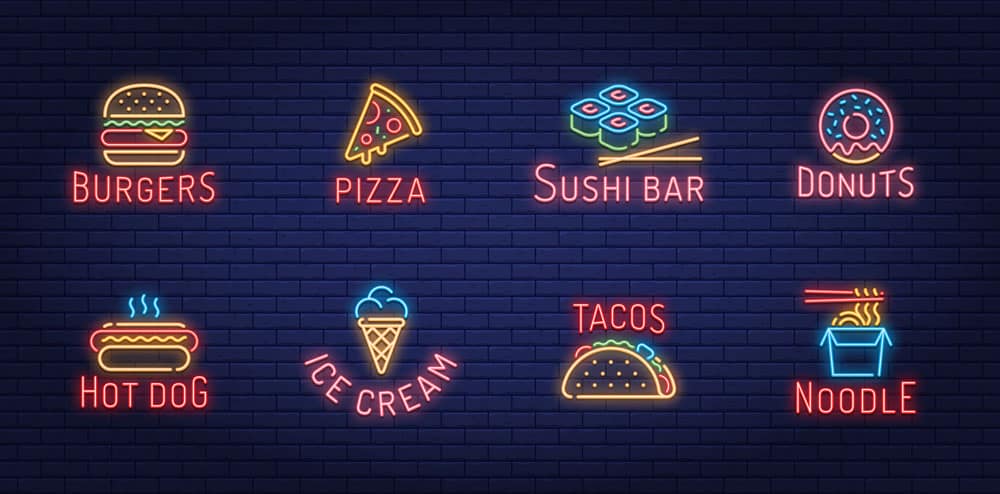Are you planning on installing a new sign and are wondering which one to go with as you consider neon lights vs. LED lights?
They are the two most popular choices regarding accent and signage lighting.
But which is the true top choice for buyers? LED lights are versatile, durable, long-lasting, and easy to install.
On the other hand, neon lights are long-lasting and have a more aesthetically pleasing light. So which one should you choose? Read on to find out.
Understanding Neon Lights and LED Lights

(Neon lights signage)
Neon lights are electricity-powered lighting relying on luminous gas discharge tubes to create light.
Generally, they have rarefied neon gas inside a sealed glass tube having a metal electrode at either end.
Traditionally, they emitted an orange color due to neon gas within the tubes.
Over time, the incorporation of other gases like helium (yellow), mercury (blue), and hydrogen (red) inside the tubes has resulted in more color patterns.
On the other hand, LED lights rely on an electric current passing through a microchip, which in turn triggers the light-emitting diodes to emit electricity.
Due to the fact that the LEDs don’t rely on external components, like gas, to produce light, they are more efficient. Specifically, they convert around 90 percent of incoming power to light energy.
Comparing the Working and Power Usage of Neon and LED Lights

(Neon lights for street food signage)
Neon and LED lights are popular across the globe for outdoor advertising and signage.
Additionally, artists use them to illuminate or improve the aesthetic appeal of individual projects or massive architectures.
But given the recent surge in LED lights’ popularity, we need to look at how the two work and their power usage.
Neon Lights Working and Power Usage
Neon lights work by relying on a high electric voltage, exciting the inert gas molecules and knocking off an electron.
Generally, inert gases don’t react with most elements in nature unless you provide a form of excitation that removes an outer electron.
When the energy is insufficient, there won’t be enough kinetic energy for the electron to escape, and you won’t detect any light.
In other words, atoms within the tube move around, colliding with each other. In the process, they transfer energy, producing much heat, and some electrons get excited.
Afterward, the electrons release the extra energy in the form of photons before returning to their original state. It’s the photon energy that we detect as light.
Additionally, the neon lights work using both alternating current (AC) and direct current (DC) energies.
The only problem is that the DC energy doesn’t oscillate, meaning you will see a glow on one end of the tube while the other remains dark.
In terms of power usage, neon lights use around 25 to 150 watts per linear foot.
However, such is a generalization; your light may use more or less than that.
LED Lights Working and Power Usage

(The LED signage)
LED lights work through the principle of electroluminescence or passing an electric current through a diode to emit light energy in the form of photons.
When you excite a diode, electrons jump from one side of a P-N junction to the other side.
In other words, they get enough energy to jump from the lower energy orbitals to higher energy level orbitals.
Conversely, they fall from the conduction bands to the lower orbitals, where they fall into P-type layer holes.
The process involves releasing energy that we see as photons or light energy.
In terms of power consumption, LEDs are very energy efficient with a high efficacy or wattage-to-lumen ratio.
In other words, LEDs are the best light source for converting electrical energy to light. Specifically, depending on the application, they can consume between 2 and 20 watts of power.
Benefits of Neon vs. LED Lights

(Visitors enjoying neon lights)
Neon lights remain popular in certain applications, such as signages all over the globe.
On the other hand, LED lights are quickly gaining popularity as people learn of the massive benefits that come with them.
Here, we are looking at why you should choose one and not the other.
Neon Lights
- Eye-catching and vibrant: Neon lights produce bright illumination that creates a visually appealing environment beneficial for signages.
- Versatile design possibilities: You can bend neon lights to create customizable lighting solutions for artistic installations and decorative accents.
- Longevity: Neon lights last for several years under good maintenance.
- Energy-efficient: While they rely on high voltages to excite the electrons, neon lights use less energy than incandescent bulbs.
- Low maintenance: Neon lights are resistant to shocks and can withstand a wide range of temperatures.
- Less toxic: Neon lights don’t contain harmful substances, including mercury, found in some light sources.
LED Lights
LED lights are advantageous in many areas as they have the following benefits:
- Longevity: LED lights have long lifespans, most averaging 50,000 hours. In other cases, high-quality LEDs last more than 100,000 hours under good maintenance.
- High efficiency: LED lights have an excellent wattage-to-lumen conversion ratio as it translates close to 90 percent of power supply to light energy.
- Low maintenance: While they require minimal maintenance, LED lights are generally low maintenance with high initial costs. Afterward, all you need to do is ensure they are free from water and debris.
- Environmentally friendly: LEDs are clean, unlike traditional light sources containing harmful chemicals like mercury. Additionally, the fact that they have high power-to-light efficiency ratios means that they don’t waste energy.
- Durability: LED lights don’t require glass housing, so they are versatile and can last long. Moreover, you can install them for underwater illumination, given they have sufficient ingress protection (IP) ratings.
FAQs
Do neon lights offer a wider range of colors compared to LED lights?
No. LED lights offer a wider range of colors compared to neon lights. Generally, the color of neon lights depends on the inert gas within the tubing.
On the other hand, LED lights offer a wide range of customization options that result in a wider range of colors.
Additionally, achieving many colors with neon lights means that you need to coat the inside of the tubing with various phosphor coatings.
As the electrons get excited, they interact with the coatings to produce various colors.
Which type of lighting requires more maintenance: neon or LED?
Generally, LED lights require less maintenance than neon lights as they have longer lifespans and are less fragile.
For instance, the lifespans of neon lights range from 20,000 to 50,000 hours.
On the other hand, that of an LED light ranges from 50,000 to 100,000 hours.
Second, neon lights have delicate glass tubes that are susceptible to breakages.
On the other hand, LEDs are solid-state devices resistant to vibrations and shocks.
Third, when neon lights break, they often require you to replace the entire tube.
On the other hand, you need to replace individual diodes if they are not functioning well anymore.
What are the environmental benefits of using LED lights over neon lights?
LED lights’ energy efficiency means that you consume less energy to produce a given amount of illumination.
Consequently, there’s less energy wastage compared to neon lights.
Furthermore, the world experiences lower greenhouse gas emissions, which in the long run, combats climate change.
Another benefit is that the lower frequency of replacement of LED lights means that there’s a reduction in waste.
Conclusion
Neon and LED lights are popular across the globe in many accent and signage lighting applications.
Traditionally, people preferred neon lights as they could create any shapes with them.
Additionally, the lights last longer, meaning they are more beneficial than traditional light sources.
However, with time, LED lights became more popular across many industries. In fact, anything that neon lights can do, the LED lights can do it better.
But that doesn’t mean that neon lights are not advantageous. Before buying a light source, weigh the pros and cons so as to make a sober choice.